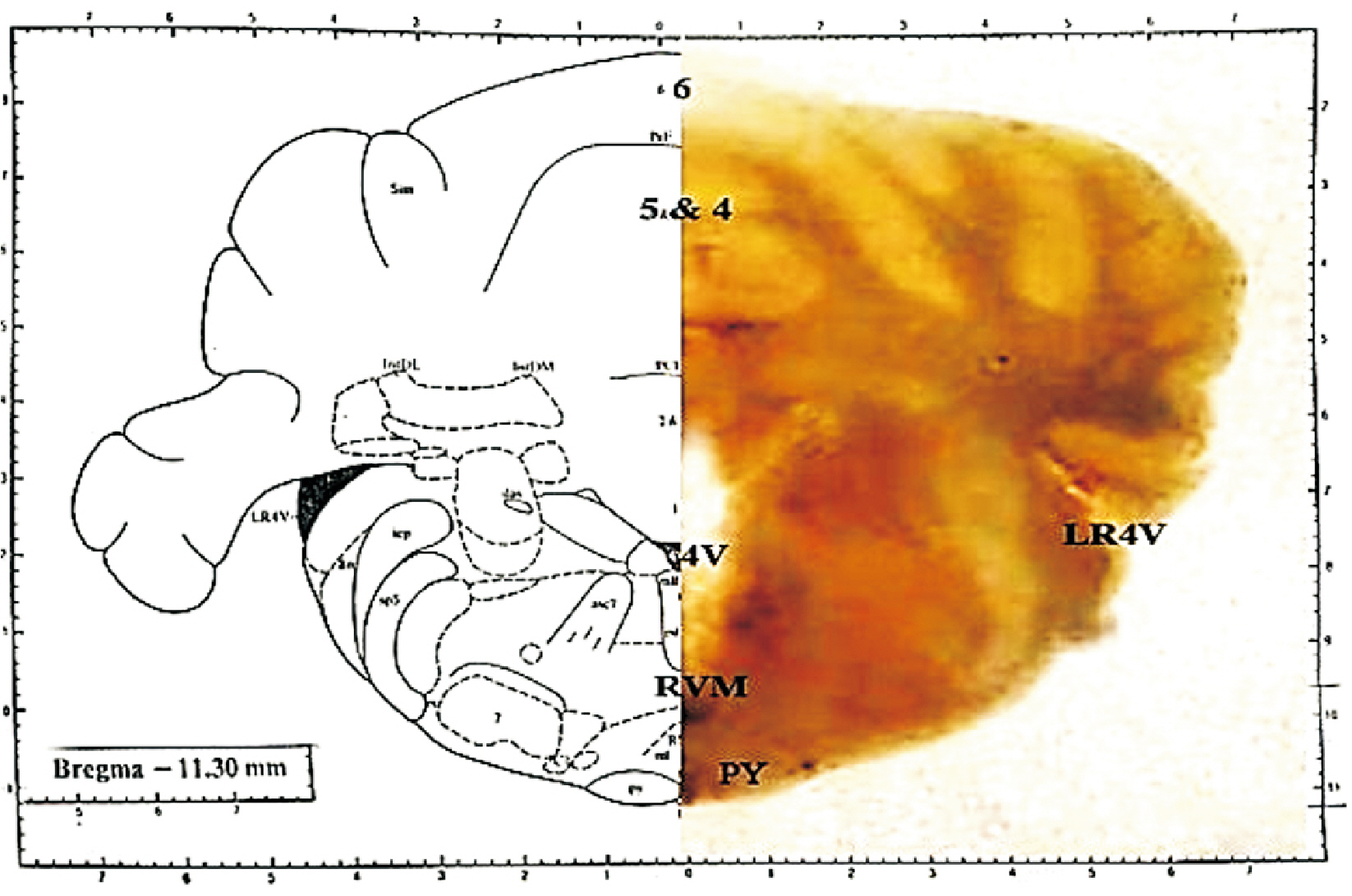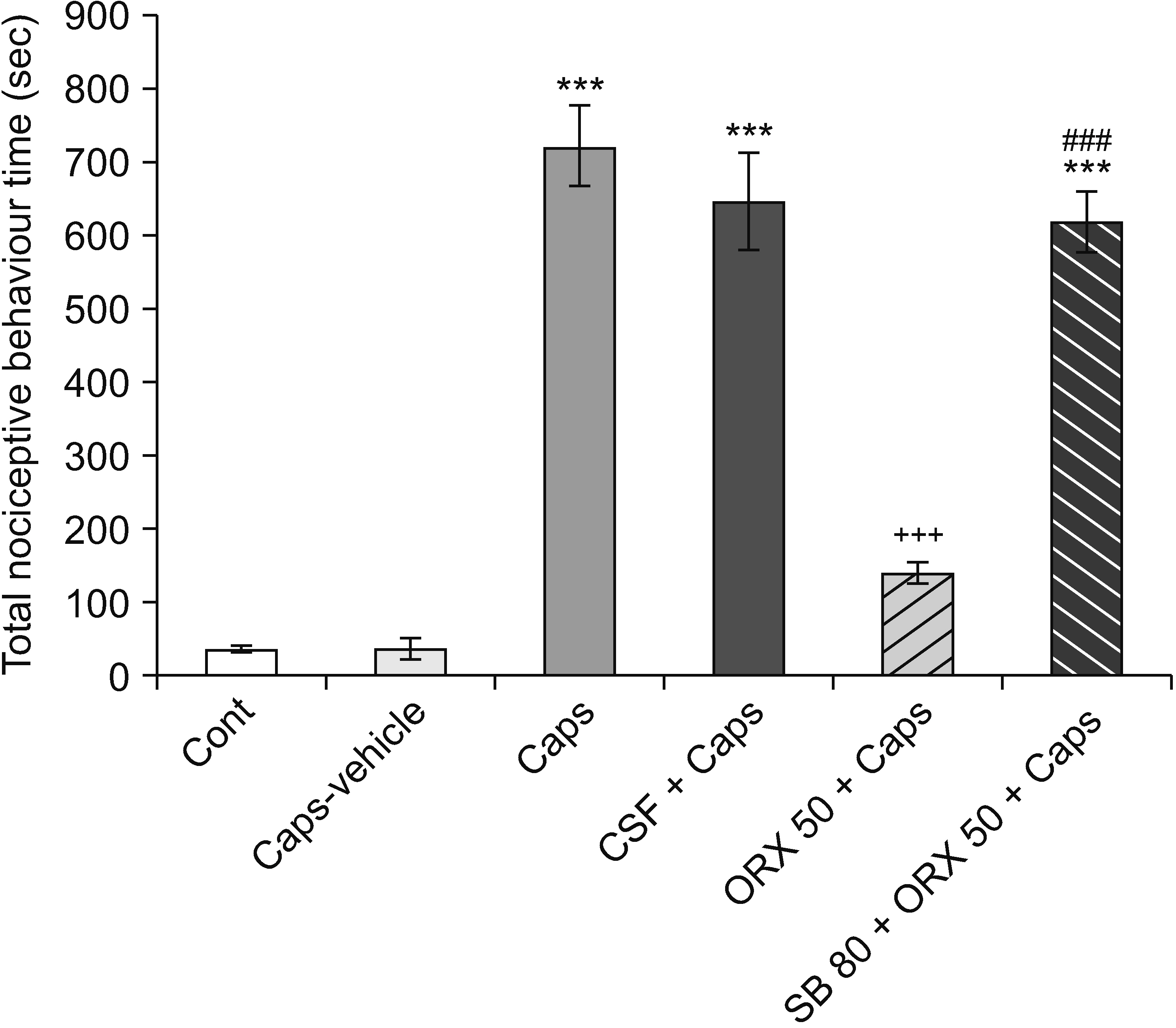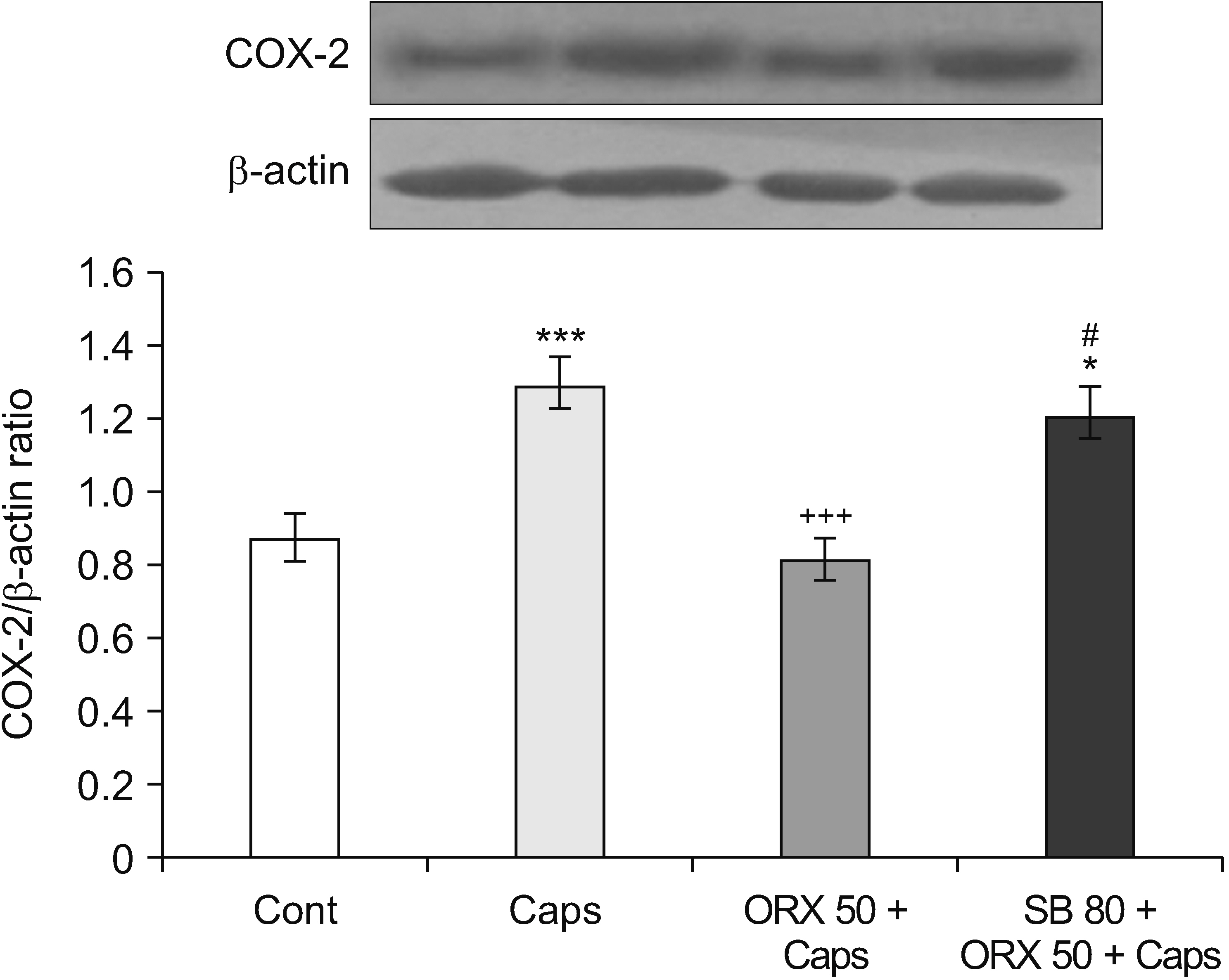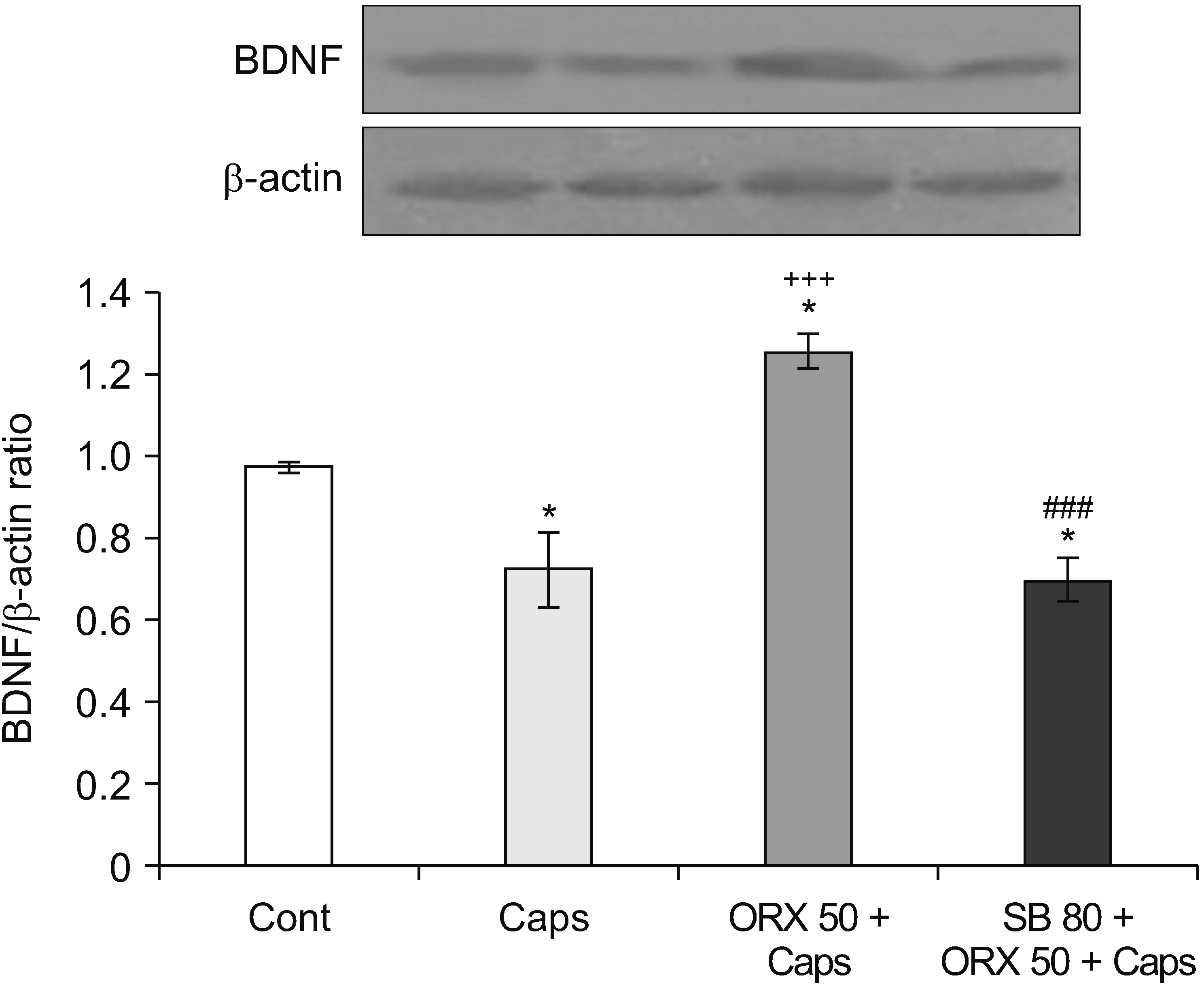Korean J Pain.
2022 Jul;35(3):261-270. 10.3344/kjp.2022.35.3.261.
The ability of orexin-A to modify pain-induced cyclooxygenase-2 and brain-derived neurotrophic factor expression is associated with its ability to inhibit capsaicin-induced pulpal nociception in rats
- Affiliations
-
- 1Department of Biology, Faculty of Sciences, Shahid Bahonar University, Kerman, Iran
- 2Neuroscience Research Center, Kerman University of Medical Sciences, Kerman, Iran
- 3Academisch Centrum Tandheelkunde Amsterdam (ACTA), University of Amsterdam and Vrije Universiteit Amsterdam, Amsterdam, The Netherlands
- KMID: 2530981
- DOI: http://doi.org/10.3344/kjp.2022.35.3.261
Abstract
- Background
The rostral ventromedial medulla (RVM) is a critical region for the management of nociception. The RVM is also involved in learning and memory processes due to its relationship with the hippocampus. The purpose of the present study was to investigate the molecular mechanisms behind orexin-A signaling in the RVM and hippocampus’s effects on capsaicin-induced pulpal nociception and cog-nitive impairments in rats.
Methods
Capsaicin (100 g) was applied intradentally to male Wistar rats to induce inflammatory pulpal nociception. Orexin-A and an orexin-1 receptor antagonist (SB-334867) were then microinjected into the RVM. Immunoblotting and immunofluorescence staining were used to check the levels of cyclooxygenase-2 (COX-2) and brain-derived neurotrophic factor (BDNF) in the RVM and hippocampus.
Results
Interdental capsaicin treatment resulted in nociceptive responses as well as a reduction in spatial learning and memory. Additionally, it resulted in decreased BDNF and increased COX-2 expression levels. Orexin-A administration (50 pmol/1 μL/rat) could reverse such molecular changes. SB-334867 microinjection (80 nM/1 μL/rat) suppressed orexin’s effects.
Conclusions
Orexin-A signaling in the RVM and hippocampus modulates capsaicininduced pulpal nociception in male rats by increasing BDNF expression and decreasing COX-2 expression.
Keyword
Figure
Reference
-
1. Takemura M, Sugiyo S, Moritani M, Kobayashi M, Yonehara N. 2006; Mechanisms of orofacial pain control in the central nervous system. Arch Histol Cytol. 69:79–100. DOI: 10.1679/aohc.69.79. PMID: 16819148.
Article2. Heinricher MM, Tavares I, Leith JL, Lumb BM. 2009; Descending control of nociception: specificity, recruitment and plasticity. Brain Res Rev. 60:214–25. DOI: 10.1016/j.brainresrev.2008.12.009. PMID: 19146877. PMCID: PMC2894733.
Article3. Porreca F, Ossipov MH, Gebhart GF. 2002; Chronic pain and medullary descending facilitation. Trends Neurosci. 25:319–25. DOI: 10.1016/S0166-2236(02)02157-4. PMID: 12086751.
Article4. Liu MG, Chen J. 2009; Roles of the hippocampal formation in pain information processing. Neurosci Bull. 25:237–66. DOI: 10.1007/s12264-009-0905-4. PMID: 19784080. PMCID: PMC5552607.
Article5. Voisin T, Rouet-Benzineb P, Reuter N, Laburthe M. 2003; Orexins and their receptors: structural aspects and role in peripheral tissues. Cell Mol Life Sci. 60:72–87. DOI: 10.1007/s000180300005. PMID: 12613659.
Article6. DiMicco JA, Samuels BC, Zaretskaia MV, Zaretsky DV. 2002; The dorsomedial hypothalamus and the response to stress: part renaissance, part revolution. Pharmacol Biochem Behav. 71:469–80. DOI: 10.1016/S0091-3057(01)00689-X. PMID: 11830181.7. Lungwitz EA, Molosh A, Johnson PL, Harvey BP, Dirks RC, Dietrich A, et al. 2012; Orexin-A induces anxiety-like behavior through interactions with glutamatergic receptors in the bed nucleus of the stria terminalis of rats. Physiol Behav. 107:726–32. DOI: 10.1016/j.physbeh.2012.05.019. PMID: 22652097. PMCID: PMC3482273.
Article8. Yeoh JW, Campbell EJ, James MH, Graham BA, Dayas CV. 2014; Orexin antagonists for neuropsychiatric disease: progress and potential pitfalls. Front Neurosci. 8:36. DOI: 10.3389/fnins.2014.00036. PMID: 24616658. PMCID: PMC3934415.
Article9. Darwinkel A, Stanić D, Booth LC, May CN, Lawrence AJ, Yao ST. 2014; Distribution of orexin-1 receptor-green fluorescent protein- (OX1-GFP) expressing neurons in the mouse brain stem and pons: co-localization with tyrosine hydroxylase and neuronal nitric oxide synthase. Neuroscience. 278:253–64. DOI: 10.1016/j.neuroscience.2014.08.027. PMID: 25168728.
Article10. Raoof M, Esmaeili-Mahani S, Nourzadeh M, Raoof R, Abbasnejad M, Amirkhosravi L, et al. 2015; Noxious stimulation of the rat tooth pulp may impair learning and memory through the induction of hippocampal apoptosis. J Oral Facial Pain Headache. 29:390–7. DOI: 10.11607/ofph.1452. PMID: 26485387.
Article11. Chuang YC, Yoshimura N, Huang CC, Wu M, Chiang PH, Chancellor MB. 2008; Intraprostatic botulinum toxin a injection inhibits cyclooxygenase-2 expression and suppresses prostatic pain on capsaicin induced prostatitis model in rat. J Urol. 180:742–8. DOI: 10.1016/j.juro.2007.07.120. PMID: 18554636.
Article12. Lee KM, Kang BS, Lee HL, Son SJ, Hwang SH, Kim DS, et al. 2004; Spinal NF-kB activation induces COX-2 upregulation and contributes to inflammatory pain hypersensitivity. Eur J Neurosci. 19:3375–81. DOI: 10.1111/j.0953-816X.2004.03441.x. PMID: 15217394.
Article13. Rahbar I, Abbasnejad M, Haghani J, Raoof M, Kooshki R, Esmaeili-Mahani S. 2019; The effect of central administration of alpha-pinene on capsaicin-induced dental pulp nociception. Int Endod J. 52:307–17. DOI: 10.1111/iej.13006. PMID: 30152861.
Article14. Merighi A, Salio C, Ghirri A, Lossi L, Ferrini F, Betelli C, et al. 2008; BDNF as a pain modulator. Prog Neurobiol. 85:297–317. DOI: 10.1016/j.pneurobio.2008.04.004. PMID: 18514997.
Article15. Pezet S, Malcangio M, McMahon SB. 2002; BDNF: a neuromodulator in nociceptive pathways? Brain Res Brain Res Rev. 40:240–9. DOI: 10.1016/S0165-0173(02)00206-0. PMID: 12589922.
Article16. Bekinschtein P, Cammarota M, Medina JH. 2014; BDNF and memory processing. Neuropharmacology. 76 Pt C:677–83. DOI: 10.1016/j.neuropharm.2013.04.024. PMID: 23688925.
Article17. Webster MJ, Herman MM, Kleinman JE, Shannon Weickert C. 2006; BDNF and trkB mRNA expression in the hippocampus and temporal cortex during the human lifespan. Gene Expr Patterns. 6:941–51. DOI: 10.1016/j.modgep.2006.03.009. PMID: 16713371.
Article18. Raoof M, Ashrafganjoui E, Kooshki R, Abbasnejad M, Haghani J, Amanpour S, et al. 2018; Effect of chronic stress on capsaicin-induced dental nociception in a model of pulpitis in rats. Arch Oral Biol. 85:154–9. DOI: 10.1016/j.archoralbio.2017.10.012. PMID: 29073563.
Article19. Lucas SM, Rothwell NJ, Gibson RM. 2006; The role of inflammation in CNS injury and disease. Br J Pharmacol. 147(Suppl 1):S232–40. DOI: 10.1038/sj.bjp.0706400. PMID: 16402109. PMCID: PMC1760754.
Article20. Inada M, Matsumoto C, Uematsu S, Akira S, Miyaura C. 2006; Membrane-bound prostaglandin E synthase-1-mediated prostaglandin E2 production by osteoblast plays a critical role in lipopolysaccharide-induced bone loss associated with inflammation. J Immunol. 177:1879–85. DOI: 10.4049/jimmunol.177.3.1879. PMID: 16849500.
Article21. Kooshki R, Abbasnejad M, Esmaeili Mahani S, Raoof M, Moeini Aghtaei MM, Dabiri S. 2018; Orexin-A inhibits capsaicin-induced changes in cyclooxygenase-2 and brain-derived neurotrophic factor expression in trigeminal nucleus caudalis of rats. Korean J Pain. 31:174–82. DOI: 10.3344/kjp.2018.31.3.174. PMID: 30013731. PMCID: PMC6037813.
Article22. Ahn DK, Choi HS, Yeo SP, Woo YW, Lee MK, Yang GY, et al. 2007; Blockade of central cyclooxygenase (COX) pathways enhances the cannabinoid-induced antinociceptive effects on inflammatory temporomandibular joint (TMJ) nociception. Pain. 132:23–32. DOI: 10.1016/j.pain.2007.01.015. PMID: 17321048.
Article23. Neeb L, Hellen P, Boehnke C, Hoffmann J, Schuh-Hofer S, Dirnagl U, et al. 2011; IL-1β stimulates COX-2 dependent PGE₂ synthesis and CGRP release in rat trigeminal ganglia cells. PLoS One. 6:e1736. DOI: 10.1371/journal.pone.0017360. PMID: 21394197. PMCID: PMC3048859. PMID: ab39d129d74d4cf2b47027dcaaad6110.24. Zhou Y, Long H, Ye N, Liao L, Yang X, Jian F, et al. 2016; The effect of capsaicin on expression patterns of CGRP in trigeminal ganglion and trigeminal nucleus caudalis following experimental tooth movement in rats. J Appl Oral Sci. 24:597–606. DOI: 10.1590/1678-775720160150. PMID: 28076465. PMCID: PMC5161258.
Article25. Hay C, de Belleroche J. 1997; Carrageenan-induced hyperalgesia is associated with increased cyclo-oxygenase-2 expression in spinal cord. Neuroreport. 8:1249–51. DOI: 10.1097/00001756-199703240-00038. PMID: 9175123.
Article26. Carlson JD, Maire JJ, Martenson ME, Heinricher MM. 2007; Sensitization of pain-modulating neurons in the rostral ventromedial medulla after peripheral nerve injury. J Neurosci. 27:13222–31. DOI: 10.1523/JNEUROSCI.3715-07.2007. PMID: 18045916. PMCID: PMC6673414.
Article27. Sanoja R, Tortorici V, Fernandez C, Price TJ, Cervero F. 2010; Role of RVM neurons in capsaicin-evoked visceral nociception and referred hyperalgesia. Eur J Pain. 14:120.e1–9. DOI: 10.1016/j.ejpain.2009.04.006. PMID: 19443247. PMCID: PMC2914578.
Article28. Kooshki R, Abbasnejad M, Esmaeili-Mahani S, Raoof M. 2016; The role of trigeminal nucleus caudalis orexin 1 receptors in orofacial pain transmission and in orofacial pain-induced learning and memory impairment in rats. Physiol Behav. 157:20–7. DOI: 10.1016/j.physbeh.2016.01.031. PMID: 26821188.
Article29. Azhdari-Zarmehri H, Semnanian S, Fathollahi Y, Pakdel FG. 2014; Tail flick modification of orexin-a induced changes of electrophysiological parameters in the rostral ventromedial medulla. Cell J. 16:131–40. PMID: 24567942. PMCID: PMC4072083.30. Ogawa Y, Irukayama-Tomobe Y, Murakoshi N, Kiyama M, Ishikawa Y, Hosokawa N, et al. 2016; Peripherally administered orexin improves survival of mice with endotoxin shock. Elife. 5:e21055. DOI: 10.7554/eLife.21055. PMID: 28035899. PMCID: PMC5245965. PMID: b97c3e7543c743b6abdc7a2ccd886b22.
Article31. Messal N, Fernandez N, Dayot S, Gratio V, Nicole P, Prochasson C, et al. 2018; Ectopic expression of OX1R in ulcerative colitis mediates anti-inflammatory effect of orexin-A. Biochim Biophys Acta Mol Basis Dis. 1864:3618–28. DOI: 10.1016/j.bbadis.2018.08.023. PMID: 30251681.
Article32. Becquet L, Abad C, Leclercq M, Miel C, Jean L, Riou G, et al. 2019; Systemic administration of orexin A ameliorates established experimental autoimmune encephalomyelitis by diminishing neuroinflammation. J Neuroinflammation. 16:64. DOI: 10.1186/s12974-019-1447-y. PMID: 30894198. PMCID: PMC6425555. PMID: 69e7f6833b604226b92795a7fa86ab95.
Article33. Raoof R, Esmaeili-Mahani S, Abbasnejad M, Raoof M, Sheibani V, Kooshki R, et al. 2015; Changes in hippocampal orexin 1 receptor expression involved in tooth pain-induced learning and memory impairment in rats. Neuropeptides. 50:9–16. DOI: 10.1016/j.npep.2015.03.002. PMID: 25817882.
Article34. Buldyrev I, Tanner NM, Hsieh HY, Dodd EG, Nguyen LT, Balkowiec A. 2006; Calcitonin gene-related peptide enhances release of native brain-derived neurotrophic factor from trigeminal ganglion neurons. J Neurochem. 99:1338–50. DOI: 10.1111/j.1471-4159.2006.04161.x. PMID: 17064360. PMCID: PMC2440676.
Article35. Trang T, Beggs S, Salter MW. 2011; Brain-derived neurotrophic factor from microglia: a molecular substrate for neuropathic pain. Neuron Glia Biol. 7:99–108. DOI: 10.1017/S1740925X12000087. PMID: 22613083. PMCID: PMC3748035.
Article36. Latremoliere A, Woolf CJ. 2009; Central sensitization: a generator of pain hypersensitivity by central neural plasticity. J Pain. 10:895–926. DOI: 10.1016/j.jpain.2009.06.012. PMID: 19712899. PMCID: PMC2750819.
Article37. Duric V, McCarson KE. 2006; Persistent pain produces stress-like alterations in hippocampal neurogenesis and gene expression. J Pain. 7:544–55. DOI: 10.1016/j.jpain.2006.01.458. PMID: 16885011.
Article38. Aubdool AA, Kodji X, Abdul-Kader N, Heads R, Fernandes ES, Bevan S, et al. 2016; TRPA1 activation leads to neurogenic vasodilatation: involvement of reactive oxygen nitrogen species in addition to CGRP and NO. Br J Pharmacol. 173:2419–33. DOI: 10.1111/bph.13519. PMID: 27189253. PMCID: PMC4945766.
Article39. Kapczinski F, Frey BN, Andreazza AC, Kauer-Sant'Anna M, Cunha ÂB, Post RM. 2008; Increased oxidative stress as a mechanism for decreased BDNF levels in acute manic episodes. Braz J Psychiatry. 30:243–5. DOI: 10.1590/S1516-44462008000300011. PMID: 18833425.
Article40. Akbari E, Naghdi N, Motamedi F. 2007; The selective orexin 1 receptor antagonist SB-334867-A impairs acquisition and consolidation but not retrieval of spatial memory in Morris water maze. Peptides. 28:650–6. DOI: 10.1016/j.peptides.2006.11.002. PMID: 17161886.
Article41. Choi YS, Cho HY, Hoyt KR, Naegele JR, Obrietan K. 2008; IGF-1 receptor-mediated ERK/MAPK signaling couples status epilepticus to progenitor cell proliferation in the subgranular layer of the dentate gyrus. Glia. 56:791–800. DOI: 10.1002/glia.20653. PMID: 18338791. PMCID: PMC4152854.
Article42. Lee S, Yang M, Kim J, Son Y, Kim J, Kang S, et al. 2016; Involvement of BDNF/ERK signaling in spontaneous recovery from trimethyltin-induced hippocampal neurotoxicity in mice. Brain Res Bull. 121:48–58. DOI: 10.1016/j.brainresbull.2016.01.002. PMID: 26772626. PMCID: PMC4783253.
Article43. Veyrac A, Gros A, Bruel-Jungerman E, Rochefort C, Kleine Borgmann FB, Jessberger S, et al. 2013; Zif268/egr1 gene controls the selection, maturation and functional integration of adult hippocampal newborn neurons by learning. Proc Natl Acad Sci U S A. 110:7062–7. DOI: 10.1073/pnas.1220558110. PMID: 23569253. PMCID: PMC3637756.44. Meyer-Tuve A, Malcangio M, Ebersberger A, Mazario J, Schaible HG. 2001; Effect of brain-derived neurotrophic factor on the release of substance P from rat spinal cord. Neuroreport. 12:21–4. DOI: 10.1097/00001756-200101220-00012. PMID: 11201084.
Article45. Yang L, Zou B, Xiong X, Pascual C, Xie J, Malik A, et al. 2013; Hypocretin/orexin neurons contribute to hippocampus-dependent social memory and synaptic plasticity in mice. J Neurosci. 33:5275–84. DOI: 10.1523/JNEUROSCI.3200-12.2013. PMID: 23516292. PMCID: PMC3640412.
Article46. Marmigère F, Givalois L, Rage F, Arancibia S, Tapia-Arancibia L. 2003; Rapid induction of BDNF expression in the hippocampus during immobilization stress challenge in adult rats. Hippocampus. 13:646–55. DOI: 10.1002/hipo.10109. PMID: 12921353.
Article47. Wang H, Ye M, Yu L, Wang J, Guo Y, Lei W, et al. 2015; Hippocampal neuronal cyclooxygenase-2 downstream signaling imbalance in a rat model of chronic aluminium gluconate administration. Behav Brain Funct. 11:8. DOI: 10.1186/s12993-015-0054-z. PMID: 25888969. PMCID: PMC4336726.
Article48. Arrigo A, Mormina E, Calamuneri A, Gaeta M, Marino S, Milardi D, et al. 2017; Amygdalar and hippocampal connections with brainstem and spinal cord: a diffusion MRI study in human brain. Neuroscience. 343:346–54. DOI: 10.1016/j.neuroscience.2016.12.016. PMID: 28003162.
Article49. Kooshki R, Abbasnejad M, Esmaeili-Mahani S, Raoof M. 2018; The effect of CA1 administration of orexin-A on hippocampal expression of COX-2 and BDNF in a rat model of orofacial pain. Arq Neuropsiquiatr. 76:603–8. DOI: 10.1590/0004-282x20180099. PMID: 30365624.
Article
- Full Text Links
- Actions
-
Cited
- CITED
-
- Close
- Share
- Similar articles
-
- Orexin-A inhibits capsaicin-induced changes in cyclooxygenase-2 and brain-derived neurotrophic factor expression in trigeminal nucleus caudalis of rats
- The effects of regular exercise on capsaicin-induced pulpal pain and pain-induced changes in passive avoidance learning and memory in rats
- Increased Expression of Brain-derived Neurotrophic Factor in Irritable Bowel Syndrome and Its Correlation With Abdominal Pain (Gut 2012;61:685-694)
- Long-term effect of vehicle resolving capsaicin applied locally to rat peripheral nerves on heat nociception : Measured by behavioral tests
- Effects of Peripheral Inflammation on Brain-Derived Neurotrophic Factor and TrkB in Rat Dorsal Root Ganglia and Spinal Cord









